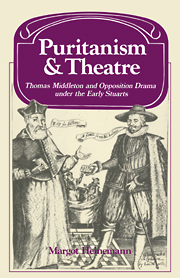Book contents
- Frontmatter
- Contents
- Introductory note
- 1 Time and Place
- 2 Puritanism, Censorship and Opposition to the Theatre
- 3 Middleton as Satirical Journalist
- 4 Early Satirical Comedies
- 5 How Anti-Puritan are Middleton's City Comedies?
- 6 Money and Morals in Middleton's City Comedies
- 7 Middle Years: Tragi-comedy and Moral Comedy
- 8 City Employments
- 9 Hard Times and Hengist, King of Kent
- 10 Political Satire: A Game at Chess
- 11 City Tragedy
- 12 Drama and Opposition, 1619–1640
- 13 From Popular Drama to Leveller Style: a Postscript
- Appendices
- Index
- Frontmatter
- Contents
- Introductory note
- 1 Time and Place
- 2 Puritanism, Censorship and Opposition to the Theatre
- 3 Middleton as Satirical Journalist
- 4 Early Satirical Comedies
- 5 How Anti-Puritan are Middleton's City Comedies?
- 6 Money and Morals in Middleton's City Comedies
- 7 Middle Years: Tragi-comedy and Moral Comedy
- 8 City Employments
- 9 Hard Times and Hengist, King of Kent
- 10 Political Satire: A Game at Chess
- 11 City Tragedy
- 12 Drama and Opposition, 1619–1640
- 13 From Popular Drama to Leveller Style: a Postscript
- Appendices
- Index
Summary
This book sets out to look at Thomas Middleton's work in relation to the society and social movements of his time, and, in particular, to trace what connections it may have had with radical, Parliamentarian or Puritan movements and groupings. The more we come to know of these complex opposition movements through the recent work of seventeenth-century historians, the less satisfactory it seems to treat Parliamentary Puritanism simply as anti-theatre, anti-dramatist. I hope this study may both suggest fresh meanings and implications in Middleton's own writings, and perhaps contribute something towards rethinking the place of drama in that confused and changing society.
The range and time-span of Middleton's work indeed make it central for such a study. He wrote his earliest poems as a boy of seventeen or eighteen in the last years of Queen Elizabeth, at the time when Henry IV and Henry V were first being acted in the popular playhouses. He was already a rising dramatist when James I came to the throne in 1603, and wrote consistently for the stage throughout the reign. By the time of his death in 1627 not only had fashions in plays changed many times – like fashions in clothes, as he said himself – but the whole social context of the theatre and its audience had been transformed. To understand Middleton's development we need to be conscious of the movement not only of theatrical taste and technique but of history.
- Type
- Chapter
- Information
- Puritanism and Theatre , pp. vii - xPublisher: Cambridge University PressPrint publication year: 1980

